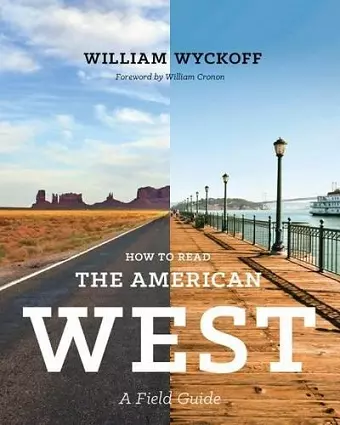How to Read the American West
A Field Guide
Format:Paperback
Publisher:University of Washington Press
Published:1st May '14
Currently unavailable, and unfortunately no date known when it will be back

Showcasing the everyday alongside the exceptional, William Wyckoff demonstrates how asking new questions about the western landscapes can let us see our surroundings more clearly, helping us make informed and thoughtful decisions about their stewardship in the twenty-first century.
Offers a fresh perspective on the natural and human history of the American West and encourages readers to discover that history has shaped the places where people live, work, and visit. This book includes stories, photographs, maps, and diagrams on a hundred landscape features across the American West.
From deserts to ghost towns, from national forests to California bungalows, many of the features of the western American landscape are well known to residents and travelers alike. But in How to Read the American West, William Wyckoff introduces readers anew to these familiar landscapes. A geographer and an accomplished photographer, Wyckoff offers a fresh perspective on the natural and human history of the American West and encourages readers to discover that history has shaped the places where people live, work, and visit.
This innovative field guide includes stories, photographs, maps, and diagrams on a hundred landscape features across the American West. Features are grouped according to type, such as natural landscapes, farms and ranches, places of special cultural identity, and cities and suburbs. Unlike the geographic organization of a traditional guidebook, Wyckoff's field guide draws attention to the connections and the differences between and among places. Emphasizing features that recur from one part of the region to another, the guide takes readers on an exploration of the eleven western states with trips into their natural and cultural character.
How to Read the American West is an ideal traveling companion on the main roads and byways in the West, providing unexpected insights into the landscapes you see out your car window. It is also a wonderful source for armchair travelers and people who live in the West who want to learn more about the modern West, how it came to be, and how it may change in the years to come.
Showcasing the everyday alongside the exceptional, Wyckoff demonstrates how asking new questions about the landscapes of the West can let us see our surroundings more clearly, helping us make informed and thoughtful decisions about their stewardship in the twenty-first century.
Watch the trailer: http://www.youtube.com/watch?v=aYSmp5gZ4-I
"[Wyckoff] encourages us to see with fresh eyes even as we're barreling down the interstate - to remember to think about the role of time in shaping a landscape, as well as the role of water. He asks us to think about who controls the landscape, and how these places have been shaped by different human interventions. . . . [How to Read the American West] is a marvelous springtime tonic for wanderlust and a wonderful invitation to see our surroundings in a new light."
-- Barbara Lloyd McMichael * Bellingham Herald *"Wyckoff has created a delightful package that would be especially useful in a classroom or, for that matter, as a gift to someone outside the field of cultural landscape studies but curious about it. . . . On the basis of its sheer good looks, the book could double as a coffee table book about the modern West."
-- Cathleen D. Cahill * Buildings & Landscapes: Journal of the Vernacular Architecture Forum *"A field guide unlike any other, with a focus on patterns, variations and the distribution of landscape features . . . it draws attention to eco-tones, watersheds, settlement patterns and corridors of connection . . . ultimately, it considers our grip on the land and the land's grip on us."
-- Michael Engelhard * High Country News *"If you like to travel the American West, put this book on your holiday gift list . . . even the experienced Western traveler will come away with new ways to look at familiar places."
-- Carl Abbott * Oregon Historical Quarterly *"William Wyckoff, a professor of geography at Montana State University and talented photographer, has created a strange, fascinating and often humorous book that surveys our modern American landscape, both natural and human-built."
-- Christian Martin * Cascadia Weekly *"Visually delightful and intellectually informative. . . . [A] truly outstanding field guide to the American West."
-- J. Clark Archer * Montana: The Magazine of Western History *"A lavish coverage of western landscapes that will trigger remembrance of past place visits, and spur an almost inescapable urge to find competing views in scanned 35 mm slides or among recent images gone straight-to-digital. . . . And the text here is fully equal to the visuals. Just in case you haven’t yet guessed, I’m going to tell you that Bill Wyckoff’s new book, a field guide explaining in delicious detail, How to Read the American West, is a movable feast of narrative and landscape elucidation. . . . So get thee into the field. Bring this book with you."
-- Paul F. Starss * The Geographic Review *"I will not hide my fandom of this book. . . . The text is clear, descriptive, and appropriately analytical for a wide audience, thus making it equally useful in the classroom. The full color pictures are gorgeous. . . . Belongs on the shelf of any scholar, amateur or professional, with interests in the western half of this country."
-- Chris W. Post * Historical GeograpISBN: 9780295993515
Dimensions: unknown
Weight: 1225g
440 pages